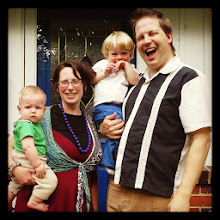Baby's First Foods: No Jars, No Blenders, Just Real Food (Baby-Led Weaning)
Baby Boy V is now a solid food eater! As people who minimize buying packaged food, jarred baby food was never on our radar. Packaged foods just create so much waste. While recycling is great, we try to do things in this order: reduce consumption (or do without), reuse something already produced, and then if there are no other options: buy something new that can later be recycled.
We talked about making our own purees, but that seemed like a lot of work. Something like the Beaba Babycook makes it look easier, but what a price tag! Biggest of all, the idea of purees—and of babies eating special, separate food— just struck me as a cultural thing rather than a universal baby well-being issue.
Enter baby-led weaning (BLW) also called baby-led solids (BLS). This method feeding, where babies feed themselves from the family meal, seemed like the perfect choice for us. The book Baby-Led Weaning by Gill Rapley was a comprehensive resource for understanding the amazingly compelling how and why of this method. The Adventures in Solid Foods blog is another wonderful source.
As V approached six months* old, he blossomed into being ready for solids per BLW guidelines. One week before his “semiversary” he became a sturdy sitter and he went from just lunging for our food to actually mock-chewing while hubby and I would eat. V had already been able to bring toys to his mouth with confidence, doubled his birth weight, and no longer had a tongue-thrust reflex.
*The six-month mark is key to BLW, but there is compelling evidence for six months as a benchmark no matter one’s solids method.
From the first week, we offered a variety of foods that generally corresponded with what we were eating:
Apple Take 1- We picked up a slice of apple from the farmer's market and let V explore while being worn close to daddy in a mei tai. He licked it twice then dropped it. Take 2- We offered another slice at home a few days later. V wasn't a fan that day either. We'll try again later.
Pear A thin slice of pear was a hit! V got off a few bites and swallowed his first food
Pork We shared from pit barbecued pork with V while eating out. He scowled at it, then mashed it around for ages in his mouth, tried a few times to swallow it, then spit it out.
Squash I pulled this out of mixed vegetables that I was sauteing for a wrap for my meal. V was tired and melting down.
Mango This was too mushy and slippery to stay in V's hand for more than a few licks. We'll try again with a heartier piece.
Water V did great with having a few sips of water from a small glass with a curved edge.
In week two he tried
Lettuce I pulled this off my sandwich while eating lunch at Chick-Fil-A with friends. V licked it, ripped it, then threw it on the floor.
Roast beef Beef au Jus was on the menu at grandma's house, so I have V a slice to hold and explore. He got off a few tiny bites and swallowed them.
Eggplant Take 1- I pulled a long wedge of eggplant out of a sauteed veggie wrap I had made for myself. He loved it and sucked all of the flesh out, leaving just the skin. V's cheeks and thighs (where he had banged the eggplant)turned red after. Perhaps something else in the wrap bothered him or maybe garlic and onions cooked in the same pan. He cleared right up with soap and water.
Pizza crust I gave V a bit of crust from a thin pizza that had a wee bit of tomato sauce on it. He like it.
Cucumber I am allergic to cucumber, but I know this is a very rare allergy our doctor said food allergies are not passed down. Cold cucumber is supposed to feel great on sore, teething gums, so I wanted V to give it a try since he got in his first two teeth that week. V mashed on it happily for a minute, then dropped it.
Pineapple Fresh off the grill (but cooled down). It was a hit, even if quite squishy.
Asparagus This was perfect for a little hand to hold onto well. We served it microwave-steamed.
Banana I am banana-phobic so hubby gave V this at breakfast while I was asleep.
Oatmeal V fed himself with a spoon from daddy's bowl
Tuna Steak We have V a small chunk of grilled tuna steak. He was ambivalent about it--just like his parents.
V will still get most of his nutrition through nursing for some time to come. But, for now solid food is great fun for experimentation, socialization, and exploring new flavors.





